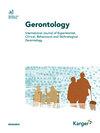简单的虚弱指数可预测住院死亡率。
IF 3
3区 医学
Q3 GERIATRICS & GERONTOLOGY
引用次数: 0
摘要
引言 比较不同环境下预测院内死亡率的虚弱模型可能会改变患者的处置和治疗方法,但模型往往很复杂。方法 在以下研究中,我们选取了一家拥有 400 张病床的地区医院的三个内科在 2020- 2021 年期间收治的所有急诊成人患者。我们试图确定:(a) 在预测院内死亡率方面,新量表(Laniado-4 量表)是否与分级诺顿量表(包括所有五个领域)一样,只包括从诺顿量表中得出的三个 "是/否 "问题,以及是否存在导尿管;(b) 确定包括新量表以及年龄、血清白蛋白和肌酐值类别的简单虚弱指数的预测价值。结果患者平均年龄为 73±19 岁,49.1%(5665/11542)为男性。在预测院内死亡率方面,Laniado-4量表优于诺顿量表。虚弱指数从0到≥8点与院内死亡率从0增加到37.7%有关,每1个指数点的几率比为2.13(2.03-2.25)。结论在预测院内死亡率方面,Laniado-4量表的效果优于诺顿量表,而且包含4个问题的量表以及年龄、血清肌酐和血清白蛋白类别的简单虚弱指数的效果也优于或好于更复杂的模型。本文章由计算机程序翻译,如有差异,请以英文原文为准。
A SIMPLE FRAILTY INDEX PREDICTS IN-HOSPITAL MORTALITY.
INTRODUCTION
Comparing frailty models in different settings that predict in-hospital mortality might modify patient disposition and treatment, but models are often complex.
METHODS
In the following study we selected all acutely admitted adult patients in 2020- 2021 to the three internal medicine departments at a regional 400-bed hospital. We attempt to determine (a) if a new scale (Laniado-4 scale) that includes only three yes/no questions derived from the Norton scale and the presence of a urinary catheter performs as well as the graded Norton scale (including all five domains), in predicting in-hospital mortality and (b) to determine the predictive value of a simple frailty index that includes the new scale as well as categories of age, serum albumin, and creatinine values. We calculated odds ratios with 95% confidence intervals and c-statistics for the various models predicting in-hospital mortality.
RESULTS
The mean patient age was 73±19 years, and 49.1% (5665/11542) were males. A Laniado-4 scale performed better than the Norton scale for predicting in-hospital mortality. A simple frailty index ranging from 0 to ≥8 points was associated with rates of in-hospital mortality that increased from 0 to 37.7%, with an odds ratio of 2.13(2.03-2.25) per 1 index point. The c-statistic was 0.887 (0.881-0.893).
CONCLUSIONS
We conclude the Laniado-4 scale performed better than the Norton scale in predicting in-hospital mortality and that a simple frailty index that included the 4-question scale and categories of age, serum creatinine, and serum albumin performed as well or better than more complicated models.
求助全文
通过发布文献求助,成功后即可免费获取论文全文。
去求助
来源期刊

Gerontology
医学-老年医学
CiteScore
6.00
自引率
0.00%
发文量
94
审稿时长
6-12 weeks
期刊介绍:
In view of the ever-increasing fraction of elderly people, understanding the mechanisms of aging and age-related diseases has become a matter of urgent necessity. ''Gerontology'', the oldest journal in the field, responds to this need by drawing topical contributions from multiple disciplines to support the fundamental goals of extending active life and enhancing its quality. The range of papers is classified into four sections. In the Clinical Section, the aetiology, pathogenesis, prevention and treatment of agerelated diseases are discussed from a gerontological rather than a geriatric viewpoint. The Experimental Section contains up-to-date contributions from basic gerontological research. Papers dealing with behavioural development and related topics are placed in the Behavioural Science Section. Basic aspects of regeneration in different experimental biological systems as well as in the context of medical applications are dealt with in a special section that also contains information on technological advances for the elderly. Providing a primary source of high-quality papers covering all aspects of aging in humans and animals, ''Gerontology'' serves as an ideal information tool for all readers interested in the topic of aging from a broad perspective.
 求助内容:
求助内容: 应助结果提醒方式:
应助结果提醒方式:


